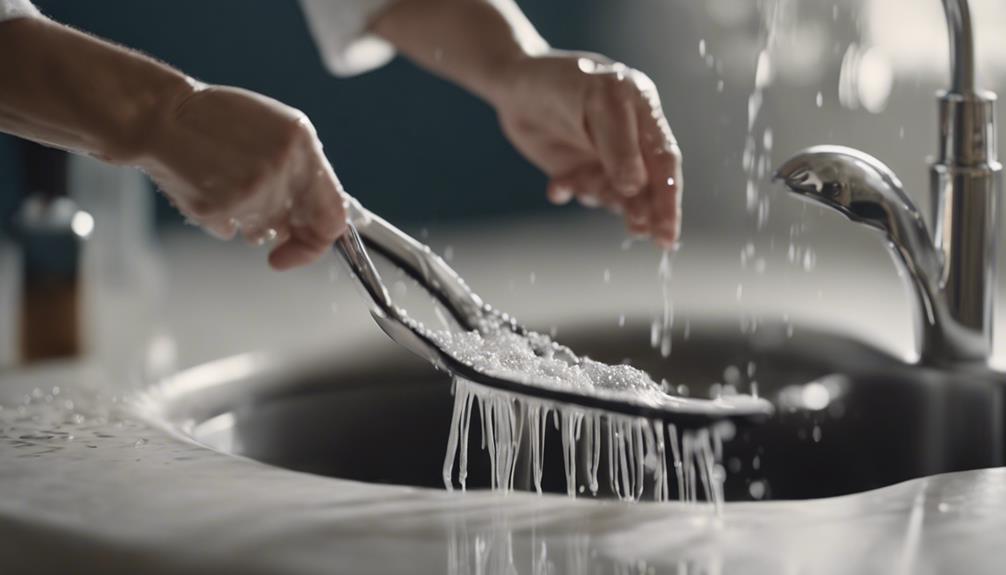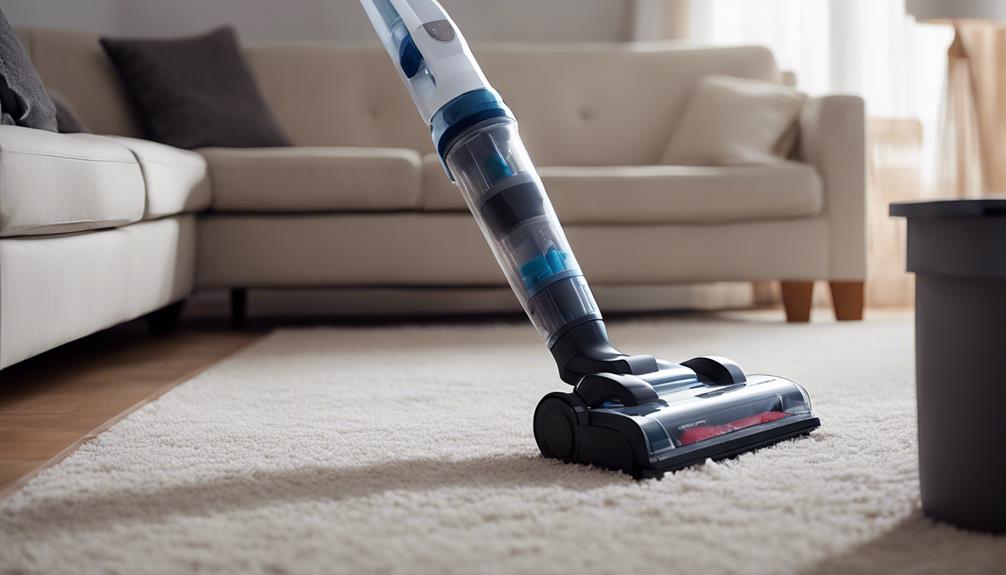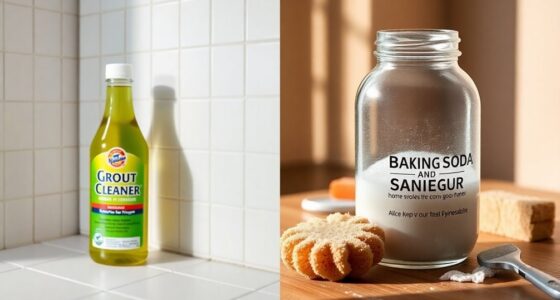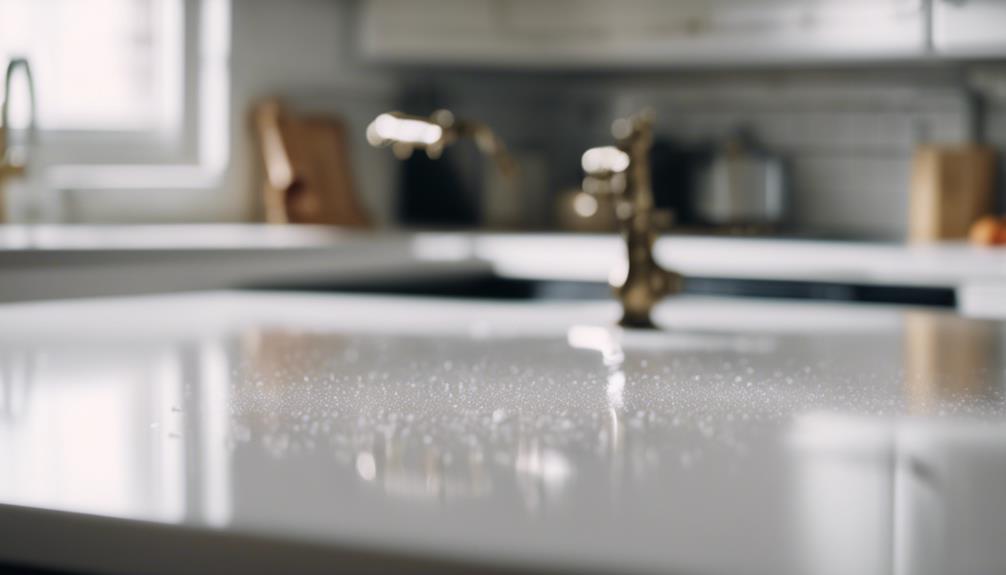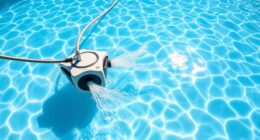To clean and sanitize utensils by hand efficiently, start by scraping off food residues. Wash with warm water and detergent, scrubbing surfaces well. Rinse with warm water to get rid of soap and debris. Sanitize by dipping in a sanitizing solution or using hot water/chemicals. Air dry to prevent contamination. Need more details on enhancing cleanliness and safety?
Key Takeaways
- Scrape off food residue before washing.
- Wash with warm water and detergent.
- Rinse thoroughly to remove soap and debris.
- Sanitize with hot water or chemical solution.
- Air dry to prevent contamination.
Scraping off Food
Before washing your utensils by hand, make sure you scrape off any food residue to effectively remove leftover particles. Scrape away remaining food using a utensil like a scraper or brush before immersing the utensils in clean water to remove any remaining debris.
Cleaning utensils by hand involves this essential step to guarantee a thorough cleaning process. By scraping off food residue, you create a clean surface that allows the water and detergent to effectively eliminate any stubborn particles. This initial step is vital in maintaining hygiene standards and preventing cross-contamination.
Using a dedicated utensil for scraping will make this task easier and more efficient. Properly scraping off food before washing your utensils sets the foundation for a successful cleaning and sanitizing process, ensuring that your utensils are thoroughly cleaned and safe to use.
Washing With Detergent

You should wash your utensils with warm water and detergent to effectively remove any food residue. Scrub the surfaces thoroughly to make sure all areas are clean, then rinse with warm water to get rid of soap and debris.
Proper washing with detergent is essential to prepare your utensils for the sanitizing step and guarantee safe food preparation.
Soap and Water Efficacy
Washing utensils with detergent effectively removes dirt, grease, and food residues for a thorough clean.
When using soap and water to clean your utensils, consider the following:
- Lathering up: Apply a generous amount of detergent to create a soapy lather that will help break down stubborn residues.
- Scrubbing power: Use a scrubbing brush or sponge to make certain the soap reaches all surfaces of the utensils, dislodging any stuck-on food particles.
- Rinsing thoroughly: Rinse the utensils under running water to wash away the loosened dirt and soap residue.
- Inspecting for cleanliness: Check visually and by touch to make sure all residues have been removed, paying particular attention to crevices and edges.
- Drying properly: After washing, allow the utensils to air dry or use a clean towel to prevent any contamination from lingering moisture.
Importance of Rinsing
Why is thorough rinsing important when washing utensils with detergent?
Rinsing plays a pivotal role in the cleaning process by helping to remove soap residues and lingering food particles from the utensils.
When you rinse utensils with warm water after washing them with detergent, you make sure that no soap or detergent taste remains, enhancing the overall dining experience.
Additionally, proper rinsing is crucial for eliminating any remaining food particles or bacteria that may still be present on the utensils after washing.
By thoroughly rinsing the utensils, you contribute to the effectiveness of the sanitization process that follows.
This step not only aids in preparing the utensils for the final sanitization but also guarantees that they're clean and safe for future use.
Sanitizing for Safety
For best safety, make certain that utensils are properly sanitized by washing them with detergent.
When sanitizing for safety, follow these steps:
- Scrape away leftover food particles: Begin by scraping off any remaining food to guarantee a thorough cleaning process.
- Wash with detergent and hot water: Use warm water and detergent to effectively remove grease and bacteria from the utensils.
- Rinse with clean water: After washing, rinse the utensils with clean water to eliminate any soap residue.
- Sanitize with hot water: To kill any remaining germs, sanitize the utensils using hot water or a chemical solution.
- Air dry to prevent contamination: Allow the utensils to air dry completely to prevent any contamination and promote proper drying.
Rinsing

You must rinse utensils thoroughly with clean water to remove any soap residue. This step is vital in ensuring that all remaining dirt or contaminants are washed away.
Importance of Rinsing
Rinsing utensils thoroughly is essential for removing soap residue and leftover food particles. Proper rinsing ensures that no harmful chemicals or contaminants remain on utensils. Thorough rinsing helps prepare utensils for the sanitization step in the cleaning process. Water temperature during rinsing can impact the effectiveness of the cleaning process. Adequate rinsing is essential to prevent cross-contamination and maintain food safety standards.
Clearing Residue: Rinsing helps clear off visible and invisible soap residue, ensuring the utensils are free from any cleaning agents.
Eliminating Food Particles: Proper rinsing dislodges leftover food particles, preventing potential contamination.
Preparing for Sanitization: Thorough rinsing readies the utensils for the sanitization step, enhancing its efficacy.
Water Temperature Impact: The temperature of the rinse water affects how well it can dislodge residues and contaminants.
Maintaining Food Safety: Adequate rinsing is critical to upholding food safety standards and preventing the spread of harmful bacteria.
Proper Rinsing Technique
Properly rinsing utensils by hand involves making sure all soap residue is effectively removed to prepare them for the sanitization process. To execute this step correctly, follow these essential steps.
To begin, after washing the utensils with detergent, proceed to rinse them thoroughly under running warm water. The warm water helps in effectively removing any remaining soap residue.
Next, be sure to rinse all parts of the utensils, including hard-to-reach areas like crevices and handles. This thorough rinsing process guarantees that all detergent is washed away, leaving the utensils clean and ready for sanitization.
Sanitizing

To effectively sanitize utensils, it's important to use the appropriate chemical solutions or hot water at specific temperatures. Proper sanitization is vital for killing any remaining bacteria and guaranteeing the utensils are safe for food preparation. Here are some key steps to follow when sanitizing utensils by hand:
- Prepare Sanitizing Solution: Mix the correct concentration of sanitizing solution following the manufacturer's instructions.
- Immerse Utensils: Submerge the cleaned utensils completely in the sanitizing solution.
- Contact Time: Allow the utensils to soak in the solution for the specified contact time to ensure effective sanitization.
- Rinse Thoroughly: After sanitizing, rinse the utensils with clean water to remove any chemical residue.
- Air Dry: Once rinsed, allow the utensils to air dry completely before storing them to prevent recontamination.
Following these steps diligently will help maintain a hygienic environment and reduce the risk of foodborne illnesses.
Air Drying

For thorough sanitization, make sure utensils are air dried completely before storing to prevent bacterial growth.
After cleaning and sanitizing your utensils by hand, it's important to allow them to air dry properly. Air drying is a key step in the process to make sure that all moisture is removed, helping to prevent any potential bacterial growth on the utensils.
Placing the utensils in a clean and well-ventilated area will aid in the drying process and reduce the risk of contamination. Avoid the temptation to wipe the utensils dry with towels post-sanitization, as this could reintroduce bacteria onto the surfaces.
By allowing the utensils to air dry fully before storage, you're maintaining hygiene standards and making certain that the sanitization process is effective.
Cleaning Utensils of Food Particles

Start by scraping off any leftover food from your utensils to guarantee they're free from debris and ready for cleaning.
Then, use warm, soapy water to thoroughly clean all surfaces of the utensils, making sure no food particles remain.
Food Particle Removal
Scrape off any leftover food particles from utensils to guarantee thorough cleaning before proceeding with washing. Ensuring all food residues are eliminated for proper hygiene and sanitation.
Here are some steps to effectively eliminate food particles from utensils:
- Use a scraper or brush to dislodge stubborn food remnants.
- Rinse utensils under running water to remove loose debris.
- Soak utensils in warm, soapy water to help loosen dried-on food.
- Scrub utensils with a sponge or brush to eliminate any remaining food particles.
- Pay close attention to crevices and edges where food particles may hide.
Proper Sanitization Techniques
To guarantee the utmost cleanliness of utensils, it's important to follow proper sanitization techniques after removing food particles. Begin by cleaning the utensils with hot soapy water, ensuring that all surfaces are thoroughly scrubbed to remove any remaining debris.
Rinse the utensils with clean water to wash away any soap residue. Next, sanitize the utensils using a chemical solution or hot water to kill off any lingering bacteria. This step is pivotal in preventing the spread of harmful germs and ensuring the safety of the utensils for future use.
Remember to allow the utensils to air-dry completely before storing or using them again. Proper drying helps to prevent the growth of bacteria that thrive in moist environments.
Using Heat or Chemical Sanitizer

For effective sanitization of utensils, consider utilizing either heat or chemical sanitizer. When using heat, hot water or steam can effectively kill germs on utensils.
On the other hand, chemical sanitizing involves using authorized sanitizing solutions to eliminate bacteria on utensils. Remember to rinse the utensils properly after sanitizing to remove any remaining chemicals.
Air drying the sanitized utensils is essential as it helps prevent recontamination before their next use.
- Hot Water or Steam: Heat sanitizing can be achieved by using hot water or steam.
- Authorized Sanitizing Solutions: Chemical sanitizing involves using authorized sanitizing solutions.
- Rinse Utensils: Properly rinse utensils after sanitizing to remove any remaining chemicals.
- Air Dry: Allow the sanitized utensils to air dry completely.
Dip in Sanitizer

After washing and rinsing your utensils, consider dipping them in a sanitizing solution to eliminate any remaining bacteria. This important step in the process of cleaning guarantees that your utensils are safe to use for food preparation. To do this, you can use a bleach solution or a commercial sanitizer following the manufacturer's instructions.
When sanitizing utensils in hot water, make sure they're completely submerged in the sanitizing solution for the recommended contact time. This contact time is necessary for the sanitizer to effectively kill any lingering bacteria and prevent foodborne illnesses.
Properly sanitized utensils provide a hygienic environment for cooking and serving food, safeguarding against potential health risks.
Boiling Metal Utensils

Consider boiling metal utensils in hot water to efficiently sanitize them and eliminate harmful bacteria and pathogens.
To properly sanitize metal utensils by hand, follow these steps:
- First Step: Bring a gallon of water to a rolling boil in a large pot.
- Utensils Preparation: Confirm the metal utensils are free from food residues before boiling.
- Boiling Process: Submerge the utensils in the boiling water for at least 10 minutes.
- Correct Temperature: Maintain the water temperature at 171 degrees Fahrenheit for best sanitization.
- Drying Stage: After boiling, allow the utensils to air-dry completely before use.
Boiling metal utensils is an efficient method to kill bacteria and pathogens, ensuring your kitchen tools are clean and safe for use. By following these simple steps, you can confidently sanitize your metal utensils by hand, promoting a hygienic cooking environment in your home.
Bleaching Plastic Utensils

To effectively sanitize plastic utensils, soak them in a diluted bleach mixture to eliminate bacteria.
When bleaching plastic utensils, it's important to use a diluted bleach solution to prevent harming the utensils.
Allow the plastic utensils to soak in the bleach mixture for the suggested time to guarantee effective sanitization.
After the appropriate soaking period, rinse the plastic utensils thoroughly to eliminate any residual bleach. This step is crucial as leftover bleach can be harmful if ingested.
Finally, air dry the plastic utensils completely before using them again to prevent any potential contamination.
Following these steps diligently will help you maintain clean and sanitized plastic utensils for safe use in your kitchen.
Frequently Asked Questions
What Is the Correct Order of Steps for Cleaning and Sanitizing?
Start by scraping debris, clean with soap and warm water, rinse well, sanitize with chemicals or hot water, and air-dry to prevent contamination. Following these steps guarantees proper cleaning and sanitizing of utensils by hand.
What Is the Correct Order for Sanitizing and Cleaning Utensils by Hand?
Start by washing utensils with soap and warm water, then rinse thoroughly. Next, sanitize using a chemical solution or hot water. Finally, let utensils air dry completely before storing or using them again to guarantee cleanliness.
What Is the Correct Order of Steps for Cleaning and Sanitizing Utensils by Hand Quizlet?
Start by scraping off food residues, wash with soap and warm water, rinse thoroughly, sanitize with chemicals or hot water, and air-dry completely. Following these steps guarantees your utensils are clean and safe for use.
What Are the 4 Steps to Cleaning and Sanitizing Utensils and Equipment?
Just like a conductor leading an orchestra, guide your cleaning process smoothly. Scrape debris, wash with soap and water, rinse well, sanitize, then let utensils air dry. Follow these steps for spotless utensils every time.
Conclusion
To sum up, following the correct sequence of steps for cleaning and sanitizing utensils by hand is essential for maintaining a safe and hygienic kitchen environment.
For instance, picture a bustling restaurant kitchen where utensils are being washed, rinsed, sanitized, and air dried in a systematic and efficient way to prevent cross-contamination and guarantee the health and safety of customers.
By following these steps diligently, you can make sure that your utensils are clean and safe to use.

